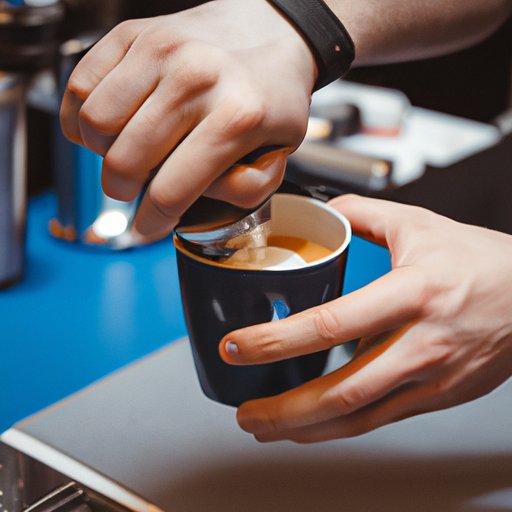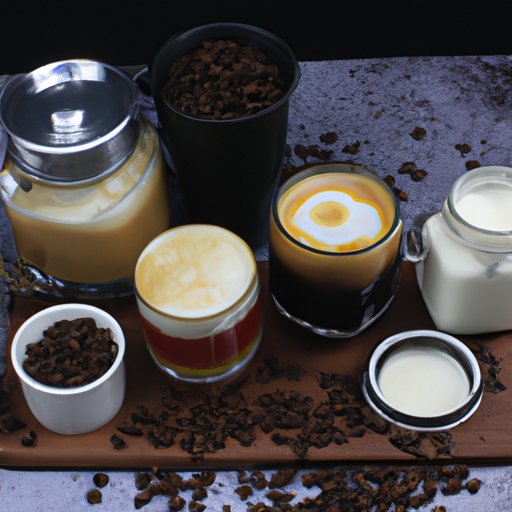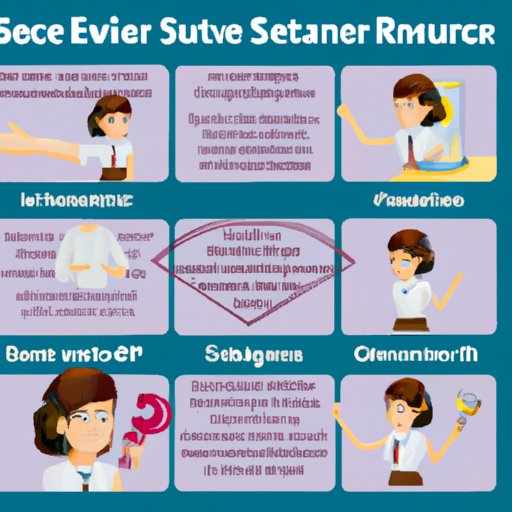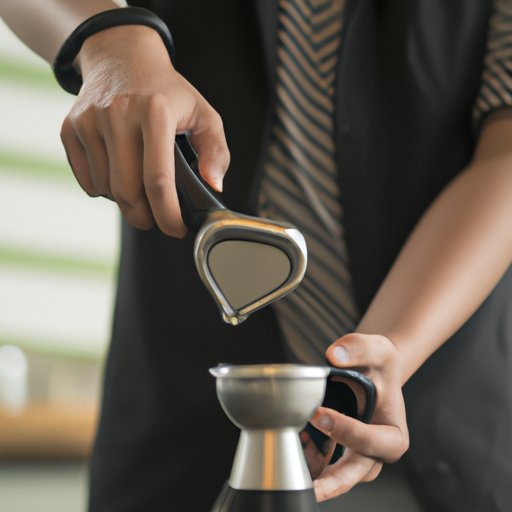Introduction
A barista is a person who specializes in preparing and serving coffee drinks. They have become an integral part of the coffee industry, providing customers with a unique experience and delicious beverages. If you’re interested in becoming a barista, there are certain qualifications and skills that you’ll need to learn and practice. This article will provide a comprehensive guide to becoming a barista, covering qualifications, types of coffee drinks, necessary equipment, customer service etiquette, and advice on how to stay organized, efficient, and productive while working as a barista.

Qualifications Necessary to Become a Barista
Becoming a barista requires a few specific qualifications and skills. According to the National Coffee Association, “Baristas should have knowledge of and experience with coffee, tea, and other specialty drinks. They should also understand the brewing process and be able to recognize quality.” Additionally, baristas must have good customer service skills, be organized, efficient, and able to handle multiple tasks simultaneously.

Types of Coffee Drinks and How to Prepare Them
One of the most important aspects of being a barista is knowing how to make different types of coffee drinks. Here are some of the most common drinks and their recipes:
Espresso
To make an espresso, start by grinding fresh coffee beans and filling the portafilter with the grounds. Then, tamp the grounds down firmly using a tamper. Place the portafilter into the espresso machine and press the start button. The espresso will take about 25 seconds to pull, and it should have a golden crema on top. Once finished, pour the espresso into a demitasse cup and serve.
Americano
An Americano is made by combining one shot of espresso with hot water. Start by pulling a shot of espresso and pour it into a mug. Then, add hot water to the mug until it reaches your desired strength and serve.
Cappuccino
To make a cappuccino, start by pulling two shots of espresso. Then, steam and froth milk using a milk steamer or frother. Once the milk has reached the desired consistency, pour it into a mug and add the espresso shots. Top the drink with foam and cocoa powder or cinnamon and serve.
Latte
A latte is similar to a cappuccino, but it has more milk than foam. To make a latte, pull two shots of espresso and steam and froth milk. Pour the espresso shots into a mug and then add the steamed milk. Top the drink with foam and serve.
Mocha
A mocha is made by combining espresso, steamed milk, and chocolate syrup. Start by pulling two shots of espresso and steaming and frothing milk. Pour the espresso shots into a mug and add the steamed milk. Then, add one to two tablespoons of chocolate syrup and stir. Top the drink with foam and serve.
Macchiato
A macchiato is made by combining espresso and steamed milk. Start by pulling one shot of espresso and steaming and frothing milk. Pour the espresso shot into a mug and then add the steamed milk. Top the drink with foam and serve.
Other Specialty Drinks
In addition to the above drinks, there are many other specialty drinks that a barista can make. These include chai lattes, iced coffees, flat whites, and more. To create these drinks, baristas need to know the recipes and ingredients for each one and be able to prepare them correctly.
Equipment Needed and How to Use It Correctly
When becoming a barista, it’s important to learn how to use the necessary equipment. Here is a list of equipment that a barista needs and how to use it correctly:
Espresso Machine
The espresso machine is used to pull shots of espresso. To use it correctly, fill the portafilter with freshly ground coffee and tamp it down firmly. Place the portafilter into the espresso machine and press the start button. The espresso will take about 25 seconds to pull, and it should have a golden crema on top.
Coffee Grinder
A coffee grinder is used to grind coffee beans for espresso. To use it correctly, fill the hopper with coffee beans and adjust the settings to the desired grind size. Turn the grinder on and let it run until all of the beans have been ground.
Milk Steamer/Frother
The milk steamer/frother is used to steam and froth milk for coffee drinks. To use it correctly, fill the container with cold milk and place it into the steamer/frother. Turn the machine on and let it run until the milk has reached the desired consistency.
Tamper
A tamper is used to press down the coffee grounds in the portafilter. To use it correctly, fill the portafilter with freshly ground coffee and place it onto a flat surface. Place the tamper on top of the portafilter and press down firmly until the coffee is compressed.
Portafilter
The portafilter is used to hold the coffee grounds when making espresso. To use it correctly, fill the portafilter with freshly ground coffee and tamp it down firmly. Place the portafilter into the espresso machine and press the start button.
Demitasse Cups
Demitasse cups are small cups used to serve espresso. To use them correctly, fill the cup with espresso and serve.
Saucers
Saucers are small plates used to serve espresso. To use them correctly, place the demitasse cup on the saucer and serve.
Spoons
Spoons are used to mix ingredients in coffee drinks. To use them correctly, fill the cup with the ingredients and mix with the spoon until they are combined.
Pitchers
Pitchers are used to store milk or other liquids for coffee drinks. To use them correctly, fill the pitcher with the desired liquid and store it in the refrigerator.
Straws
Straws are used to sip coffee drinks. To use them correctly, place the straw into the cup and use it to sip the drink.

Customer Service Etiquette and Tips for Interacting With Customers
Good customer service is essential for any barista. Here are some tips for interacting with customers:
Greeting Customers
When greeting customers, it’s important to be friendly and welcoming. Smile and introduce yourself to the customer and ask them how they are doing. Make sure to thank them for coming in and let them know you’re happy to help.
Taking Orders
When taking orders, it’s important to listen carefully to the customer and repeat back the order to make sure it is correct. Ask questions if there is something you don’t understand and offer suggestions if the customer seems unsure of what they want. Also, make sure to write down the order clearly so that there are no misunderstandings.
Making Suggestions
It’s often helpful to suggest additional items to customers. For example, if someone orders a latte, you can suggest adding a flavor shot or topping. This is a great way to upsell and increase sales.
Upselling
Upselling is another way to increase sales. When a customer orders a drink, you can suggest they upgrade to a larger size or add an extra shot of espresso. This is a great way to increase profits without requiring too much extra work.
Handling Complaints
No matter how well you do your job, there will always be customers who have complaints. It’s important to remain calm and professional when dealing with these customers. Listen to their complaint and apologize for any inconvenience caused. Offer to remake the drink or give them a free drink voucher to make up for the mistake.
Closing Interactions
When closing interactions with customers, it’s important to thank them for coming in and wish them a good day. You can also offer to make any future visits more enjoyable by suggesting new menu items or offering discounts.
Advice on How to Stay Organized, Efficient, and Productive While Working as a Barista
Being a successful barista requires organization, efficiency, and productivity. Here are some tips on how to stay organized, efficient, and productive while working as a barista:
Stocking Supplies
It’s important to keep the workspace stocked with supplies, such as coffee beans, espresso, syrups, and other ingredients. This will ensure that everything is ready to go when customers come in and orders need to be made quickly.
Cleaning Work Area
Baristas should clean their work area regularly to keep it tidy and organized. This will help to maintain a safe and sanitary environment and make the workspace more efficient.
Scheduling Breaks
Baristas should schedule regular breaks throughout their shift to stay refreshed and energized. Taking short breaks throughout the day will help to prevent burnout and keep the barista focused and productive.
Setting Priorities
It’s important to set priorities and focus on one task at a time. This will help to ensure that all tasks are completed in a timely manner and that nothing gets overlooked.
Time Management
Baristas should practice good time management to stay on top of their workload. This means setting deadlines, making lists, and staying organized.
Multi-tasking
Baristas should practice multi-tasking to get through their workload more quickly. This means being able to switch between tasks quickly and effectively.
Conclusion
Becoming a barista is a rewarding career that requires knowledge, skill, and dedication. To become a successful barista, one must understand the qualifications and skills necessary, have knowledge of different types of coffee drinks and how to prepare them, know how to use the necessary equipment correctly, practice good customer service etiquette, and stay organized, efficient, and productive while working as a barista. We hope this article has provided a comprehensive guide on how to become a barista.
(Note: Is this article not meeting your expectations? Do you have knowledge or insights to share? Unlock new opportunities and expand your reach by joining our authors team. Click Registration to join us and share your expertise with our readers.)
